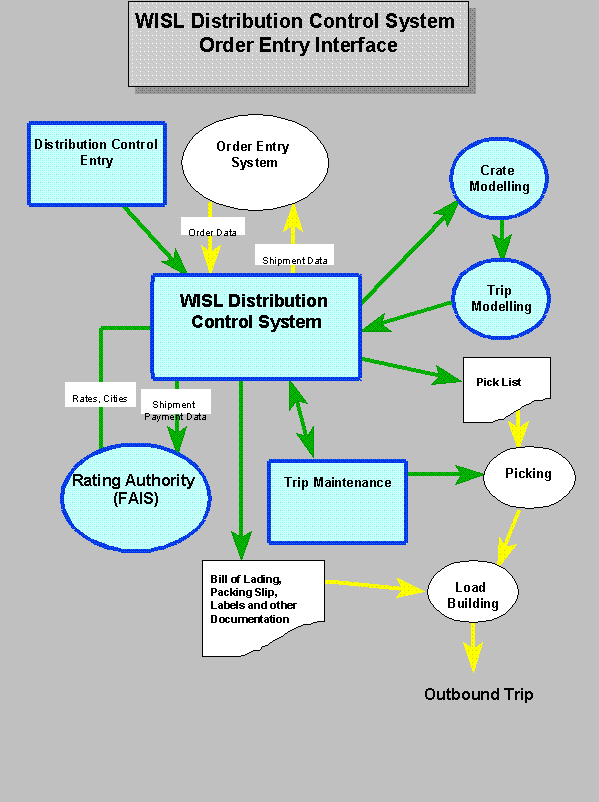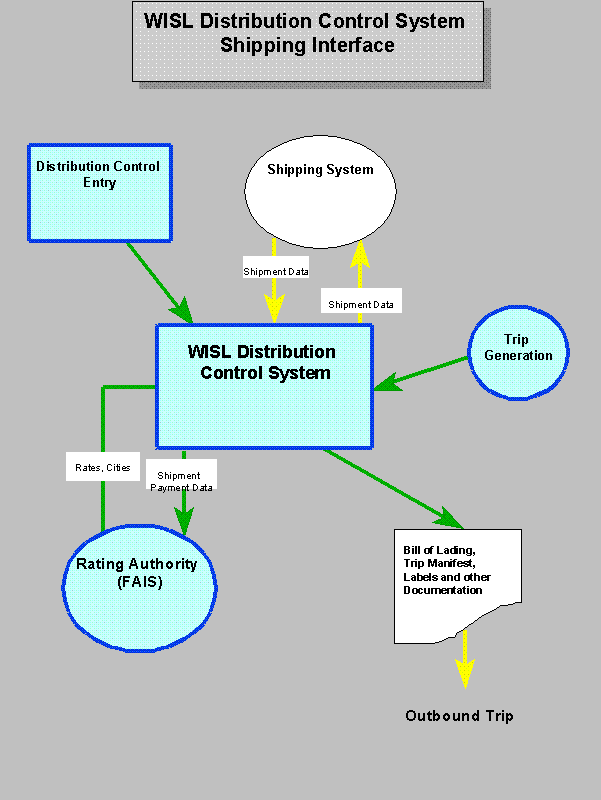
WISL Distribution Control System
Overview
Waterloo Information Systems Limited
33 Dupont Street East
Waterloo, Ontario
N2J 2G8
© Waterloo Information Systems Limited 1995
The information contained herein is proprietary and considered a trade secret of Waterloo Information Systems Limited and shall not be reproduced in whole or in part without the written authorization of Waterloo Information Systems Limited.
I. Introduction
The WISL Distribution Control System directs the distribution of shipments from one or more dock locations and provides an interface between order or shipment data base functions and distribution operations. It can be coupled with a shipping system such as WISL's Branch Freight System and provide distribution control for LTL shipments or accept input from an order entry system and allow the automatic generation of loading units and the configuration of trips for truckload shipping.
Shipment information can also be accepted through custom interface with a shipping system or via EDI transactions. Delivery carrier, truck and/or route can be automatically determined based on the type and destination of the shipment. Shipments can be readily sorted to facilitate the accumulation of LTL shipments into appropriate trips.
The shipment or pro-bill ID may be automatically assigned by the system or input from a label affixed to the shipment. If barcode labels are utilized, WISL Distribution Control provides streamlined interactive routines in the loading module to record physical movement of shipments by laser scanning, including RF scanning networks.
In its alternate form, information collected from picking or order entry systems can be automatically transferred into the distribution system, and any supplementary orders can be manually entered. WISL DCS incorporates the capability to automatically generate loading units(eg crates or pallets) from the order file based on criteria stored on sku records and input modelling parameters. The result of the crate modelling procedure is crated or palleted shipments consolidated by consignee. The modelled loading units may then be input to the trip modelling procedure which provides for specification of parameters such as maximum radius of combined shipping points, percentage of maximum load to constitute a trip, maximum loading units per trip and maximum number of stop-offs. The trip modelling function interfaces with a third party mileage/routing facility and WISL's automatic rating capability to optimize the generation of trips.
The trip modelling facility is an iterative procedure that is designed to be run with varying parameters until the desired result is achieved. Trip records generated by the automatic procedure may be maintained(loading units or shipment/orders may be added or deleted) before they are locked for loading and documentation generated.
The Order/Shipment Tracking facility consists of an inquiry routine capable of employing multiple search criteria for tracking order/shipments entered into the system; in addition the Call Tracing function allows the recording of inquiry information for follow-up.
Shipping Interface Functions
- accepts EDI 204 transactions
- accepts manual entry of shipments
- offers complete record keeping to control delivery by own fleet including equipment tracking
- provides for sorting of shipment records to facilitate generation of trips
Order Entry Interface Functions
Maintenance routine
- accepts manual entry of orders
- accepts transactions from an order entry or shipment picking system
- provides an error report for inconsistencies in order records
Inquiry Routine
- inquiry on individual order records to sku detail
- allows for view of orders by trip, consignee or carrier
Crate Modelling Routine
- volume of each sku order segment can be determined from criteria stored by sku
- volume of the loading unit(crate, pallet etc) can be specified by parameter along with maximum fill percentage
- the routine fills loading units in oldest date priority order attempting to keep orders together and minimize the number of partial orders in a single unit
- crate modelling supports two of the goals of trip modelling: to ensure that orders are not split between trips and older orders are given load priority
Trip Modelling Routine
- trip modelling attempts to build trips that are optimal in terms of route and cost while giving priority to older dated orders
- the routine is integrated with a third party mileage/routing facility and with WISL's automatic rating system
- parameters that may be specified by run include number of stop-offs, maximum radius for delivery of a trip in miles, maximum loading units per vehicle, maximum miles per day and percentage full to be considered a trip
- the age of an order that must be loaded may be specified in days
- the trip modelling process is intended to be iterative with changes in the parameters
- upon satisfaction with the results produced by a model, the trip records may be saved and used as the basis for loading and document generation
TL Trip Maintenance Function
- pick lists are generated from the trip records to control the picking process
- order records contained within a specific trip may be modified or added before generation of documentation(usually based on information gained from the picking process)
WISL RF Picking & Load Validation Interface
- WISL offers an RF scanning based picking and load validation product that is readily interfaced with WDC.
Tracking and Tracing Functions
- shipment tracking and inquiry is available on current and past shipments order detail is available where order entry systems are interfaced
- a tracing facility is available to record and follow-up on status inquiries
In addition to the above main functions, two supervisory functions are provided.
Reporting Function
- trip manifests and labels for LTL shipments
- TL trip documentation including:
packing list
loading unit(crate, pallet etc) labels
order labels
sku shipping unit labels
bills of lading
commercial invoice
- loading reports including:
- loading report by trip
- unloaded crates
- trip sku summary
- model inventory impact
- crate reports
- order reports
- consignee reports
Supplementary File Maintenance Function
- maintenance for system files
- carriers
- loading terminals
- consignees
- terminals
- road equipment
- system parameters
The implementation of the WISL Distribution Control System incorporates the conversion or integration of any existing data files, such as customers, consignees, etc. into WISL Distribution Control formats.

